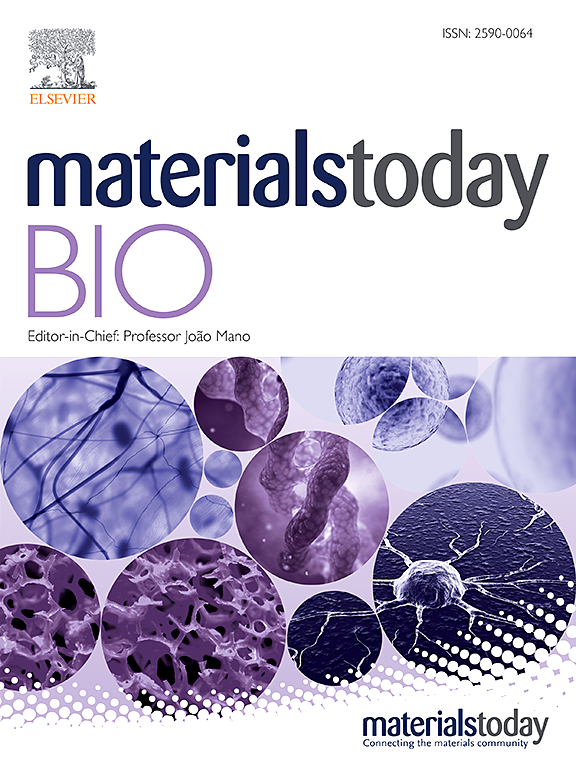生物医学应用的金属有机骨架(MOF)-生物活性玻璃(BG)系统综述。
IF 8.7
1区 医学
Q1 ENGINEERING, BIOMEDICAL
引用次数: 0
摘要
近年来,金属有机框架(mof)因其优越的化学通用性、独特的结构性能和增强的机械性能而成为生物医学应用的有前途的材料。然而,它们的快速和不受控制的降解以及生物活性的降低限制了它们的临床潜力。为了克服这些限制,mof可以与其他材料协同结合,例如生物活性玻璃(BGs),以其生物活性和治疗性离子释放能力而闻名。除了比较MOFs和BGs外,本文还介绍了不同MOFs/BGs材料的最新研究成果,重点介绍了它们的互补和协同特性。关键研究结果表明,mof和BGs的结合可以开发出具有优异物理化学和生物性能的复合材料。此外,通过选择合适的加工工艺,BGs和mof可以制成具有快速矿化能力和高耐腐蚀性的支架或涂层。此外,在水凝胶中掺入mof /BGs可提高水凝胶的机械稳定性、生物活性和抗菌性能,同时保持生物相容性。抗菌性能背后的机制,可能来自金属离子和有机配体的释放,也进行了讨论。综上所述,本文综述了mof和bg协同应用在生物医学领域的研究方向和新趋势,为开发新型先进治疗材料家族提供了新思路。本文章由计算机程序翻译,如有差异,请以英文原文为准。

Metal-organic framework (MOF)-bioactive glass (BG) systems for biomedical applications - A review
In recent years, metal-organic frameworks (MOFs) have emerged as promising materials for biomedical applications, owing to their superior chemical versatility, unique textural properties and enhanced mechanical properties. However, their fast and uncontrolled degradation, together with the reduced bioactivity have restricted their clinical potential. To overcome these limitations, MOFs can be synergistically combined with other materials, such as bioactive glasses (BGs), known for their bioactivity and therapeutic ion releasing capabilities. Besides comparing MOFs and BGs, this review aims to present the latest achievements of different MOFs/BGs materials, with a particular focus on their complementary and synergistic properties. Key findings show that combining MOFs and BGs enables the development of composite materials with superior physicochemical and biological properties. Moreover, by choosing appropriate processing techniques, BGs and MOFs can be fabricated as scaffolds or coatings with fast mineralization ability and high corrosion resistance. In addition, incorporation of MOFs/BGs in hydrogels improves mechanical stability, bioactivity and antibacterial properties, while maintaining biocompatibility. The mechanisms behind the antibacterial properties, likely coming from the release of metal ions and organic ligands, are also discussed. Overall, this review highlights the current research directions and emerging trends in the synergistic use of MOFs and BGs for biomedical applications, which represents a novel strategy for developing a new family of advanced therapeutic materials.
求助全文
通过发布文献求助,成功后即可免费获取论文全文。
去求助
来源期刊

Materials Today Bio
Multiple-
CiteScore
8.30
自引率
4.90%
发文量
303
审稿时长
30 days
期刊介绍:
Materials Today Bio is a multidisciplinary journal that specializes in the intersection between biology and materials science, chemistry, physics, engineering, and medicine. It covers various aspects such as the design and assembly of new structures, their interaction with biological systems, functionalization, bioimaging, therapies, and diagnostics in healthcare. The journal aims to showcase the most significant advancements and discoveries in this field. As part of the Materials Today family, Materials Today Bio provides rigorous peer review, quick decision-making, and high visibility for authors. It is indexed in Scopus, PubMed Central, Emerging Sources, Citation Index (ESCI), and Directory of Open Access Journals (DOAJ).
 求助内容:
求助内容: 应助结果提醒方式:
应助结果提醒方式:


